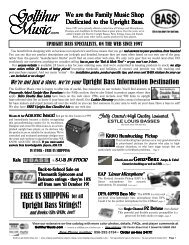MAKE FRIENDS WITH YOUR AMP - Gollihur Music
MAKE FRIENDS WITH YOUR AMP - Gollihur Music
MAKE FRIENDS WITH YOUR AMP - Gollihur Music
Create successful ePaper yourself
Turn your PDF publications into a flip-book with our unique Google optimized e-Paper software.
P age | 2<br />
W<br />
e spend hours learning and practicing bass, not to mention fussing for hours over strings and accessories, and<br />
agonizing over pickup and/or mic choices. However, the amplifier is often overlooked; we plug it in, twiddle<br />
the knobs a little bit, and that’s often the end of it. It’s important to understand EVERY component of the sound you<br />
project. I’ve heard a lot of amplified basses; and sounding “bassy” = sounding “muddy.” MUMBLE, RUMBLE, BLOBBY-<br />
BLOBBY, THUD, THUD is not a good bass sound.<br />
FAMILIARIZE <strong>YOUR</strong>SELF <strong>WITH</strong> WHAT TONE CONTROLS ACTUALLY DO<br />
The whole point of this exercise is this:<br />
When you are playing and something just doesn’t sound quite right, you will instinctively<br />
know which knob to adjust.<br />
This is a valuable talent well worth learning. I could use more technical jargon and scientific precision in this e-guide,<br />
but we’re going for general knowledge and results in these exercises, so pardon the<br />
“layman’s terms.”<br />
Most amps feature “tone” controls labeled Bass, Middle, and Treble; each control a<br />
band of frequencies. “EQ” (equalization) is a common way to refer to these tone<br />
controls. You are probably quite aware of the effect twisting those knobs has when<br />
you’ve adjusted a radio or stereo unit. For instance, turning the bass knob all the<br />
way up and the treble all the way down sounds like listening to a song being<br />
played in the next room with the door closed.<br />
Tone controls split the spectrum of sound into chunks, sort of like the piano keyboard<br />
splits in the image to the right (not precise, the drawing is only to illustrate the<br />
concept). The controls let you boost or cut those frequency bands. The other drawing<br />
is the frequencies of some notes on the upright (or electric) bass fingerboard.<br />
Speaking generally, the lowest (bass) control usually affects the frequencies around<br />
the fundamental of the notes we play on our basses. But, for example, when you<br />
play the open A string on your bass, you hear a lot more than just that original note<br />
(aka the fundamental). There are also overtones (aka harmonics) above that note<br />
that give it character and clarity. Severely cutting the middle and high frequencies<br />
down (by turning down the midrange, treble or whatever your amp has) reduces<br />
your amp’s delivery of those harmonics and can hurt clarity.<br />
Note: If you have a graphic equalizer with more than just “low-mid-high,” those sliders<br />
are just further splitting the frequencies into finer slices – low lows, middle lows, high<br />
lows, low mids, middle mids, etc., so you have even more precise control over the total<br />
sound.<br />
Make Friends With Your Amp – by Bob <strong>Gollihur</strong><br />
Courtesy of <strong>Gollihur</strong> <strong>Music</strong> • www.<strong>Gollihur</strong><strong>Music</strong>.com • ALL MATERIAL ©COPYRIGHT 2012 BOB GOLLIHUR




